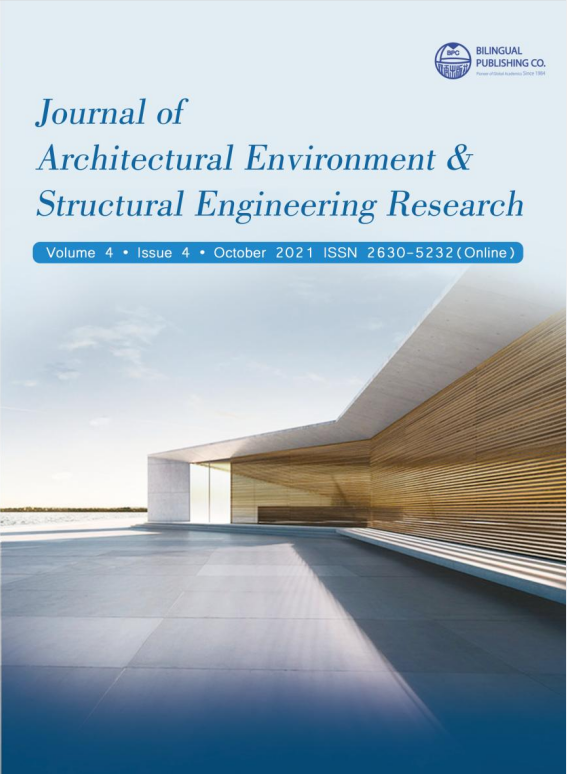-
2124
-
1857
-
1631
-
1560
-
1525
Thermal Impacts of the Internal Courtyards in Compound Houses: The Case of Tamale Metropolis
DOI:
https://doi.org/10.30564/jaeser.v4i4.3790Abstract
The research seeks to understand the effects of internal courtyards onthermal comfort conditions in compound houses in Ghana’s TamaleMetropolitan area. Internal courtyards are an integral part of the design ofcompound houses in this location.Their inclusion in building designs is largely as a point of domestic activitysuch as cooking and cleaning and also for social interaction. However, a lotof interchanges in thermal conditions between structures and the outdoorstake place within these internal courtyards. Various design details of thebuilding will engender different thermal responses of the internal courtyard.This paper assesses thermal comfort in compound houses as againstbungalow type houses in the Tamale Metropolis, Ghana by the applicationof the Predicted Percentage of Dissatisfied Persons (PPD) and PredictedMean Votes (PMV) model. This prototype compares with the InternationalStandards Organization (ISO) 7730 and American Society of Heating,Refrigeration and Air-Conditioning Engineers (ASHRAE) Standard 55(estimated values between 23˚C - 26˚C seen as the allowable temperatures).Ambient indoor conditions (dry bulb temperature and relative humidity)of five (5) buildings each from the two building typologies from wererecorded over a period of ten calendar months. These ambient conditionswere analyzed, consequently generating the Predicted Percentage ofDissatisfied Persons (PPD) and Predicted Mean Votes (PMV) recordings.The investigations uncovered relatively high PPD - PMV recordingsrelating to the Bungalow type buildings while the compound housesattune to the comfort zone. The Actual Mean Votes (AMV) of residentssuggests the two building typologies are all rated comfortable however; thecompound houses are rated above the bungalow type houses.Keywords:
Compound house, Internal courtyard, Thermal comfort, ASHRAE criterion 55, Tamale metropolisReferences
[1] Givoni, B., 1994. Passive and Low Energy Cooling of Buildings. 1st Edn, Van Nostrand Reinhold, New York, ISBN: 0471284734, pp: 4.
[2] Budaiwi, I.M., 2006. An approach to investigate and remedy thermal-comfort problems in buildings. Build. Environ, 42: 21 24-2131.
[3] Al-Hemiddi, N.A. and K.A. Megren Al-Saud, 2001. The effect of a ventilated interior courtyard on the thermal performance of a house in a hot-arid region. Renewable Energy, 24: 581-595.
[4] Muhaisen, A.S. and M.B. Gadi, 2006. Effect of courtyard proportions on solar heat gain and energy requirement in the temperate climate of Rome. Build. Environ. 41: 245-253.
[5] GSS. (2012). 2010 population and housing census: Summary report of final results. Accra: Ghana Statistical Service.
[6] Abankwa, V., Grimard, A., Sommer, K., & Kuria, F. (2009). Ghana: Tamale city profile. Nairobi: Regional Technical Cooperation Division, UN-Habitat.
[7] Ghana Meteorological Service, 2018.
[8] Ibrahim Yakubu*, Millicent Awialie Akaateba, Bernard A.A. Akanbang,(2014) A study of housing conditions and characteristics in the Tamale Metropolitan Area, Ghana, Habitat International Vol. 44 pp 394-402.
[9] Nicol, F.G. (2001) Characterising Occupant Behaviour in Buildings: Towards a Stochastic Model of Occupant Use of Windows, Lights, Blinds, Heaters and Fans. Proceedings of 7th International IBPSA Conference, Rio de Janeiro, 13-15 August 2001, 1073-1078.
[10] Brager, G.S. and De Dear, R.J. (1998) Thermal Adaptation in the Built Environment: A Literature Review. Energy and Buildings, 27, 83-96.
[11] Oseland, N.A. (1995) Predicted and Reported Thermal Sensation in Climate Chambers, Offices and Homes. Energy and Buildings, 23, 105-115. DOI: http://dx.doi.org/10.1016/0378-7788(95)00934-5.
[12] American Society of Heating, Refrigerating and Air-Conditioning Engineers (ASHRAE) (2004) Standard 55-2004 & Standard 55-1992, Thermal Environmental Conditions for Human Occupancy. ASHRAE, Atlanta.
[13] ISO 7730 (2005) Moderate Thermal Environments Determination of the PMV and PPD Indices and Specifications for Thermal Comfort. 2nd Edition, International Organization for Standardization, Geneva.
[14] Szokolay, S. (2004) Introduction to Architectural Science: The Basis of Sustainable Design. Architectural Press, Oxford, 17.
[15] Hyde, R. and Sabarinah, S.A. (2008) Bioclimatic Housing, Innovative Designs for Warm Climates. Earthscan, UK & USA.
[16] Humphreys, M.A. and Nicol, J.F. (2002) The Validity of ISO-PMV for Predicting Comfort Votes in Everyday Thermal Environments. Energy and Buildings, 34, 667-684. DOI: http://dx.doi.org/10.1016/S0378-7788(02)00018-X.
[17] Fanger, P.O. (1970) Thermal Comfort. Danish Technical Press. Copenhagen.
[18] de Dear, R.J. and Brager, G.S. (2002) Thermal Comfort in Naturally Ventilated Buildings: Revision to ASHRAE Standard 55. Energy and Buildings, 34, 549-561. DOI: http://dx.doi.org/10.1016/S0378-7788(02)00005-1
[19] Beizaee, A., Firth, S.K., Vadodaria, K. and Loveday, D. (2012) Assessing the Ability of PMV Model in Predicting Thermal Sensation in Naturally Ventilated Buildings in UK. 7th Windsor Conference: The Changing Context of Comfort in an Unpredictable World, Windsor, 12-15 April 2012, Network for Comfort and Energy Use in Buildings, London. http://nceub.org.uk.
[20] Han, J., Zhang, G., Zhang, Q., Zhang, J., Liu, J., Tian, L., Zheng, C., Hao, J., Lin, J., Liu, Y. and Moschandreas, D.J. (2007) Field study on Occupants’ Thermal Comfort and Residential Thermal Environment in a Hot-Humid Climate of China. Building and Environment, 42, 4043-4050. DOI: http://dx.doi.org/10.1016/j.buildenv.2006.06.028.
[21] Heidari, S. and Sharples, S. (2002) A Comparative Analysis of Short-Term and Long-Term Thermal Comfort Surveys in Iran. Energy and Buildings, 34, 607-614. DOI: http://dx.doi.org/10.1016/S0378-7788(02)00011-7.
[22] Barbara Simons, Christian Koranteng, Emmanuel Adinyira and Joshua Ayarkwa, (2014) An Assessment of Thermal Comfort in Multi Storey Office Buildings in Ghana, Journal of Building Construction and Planning Research, 2014, 2, 30-38.
[23] Koranteng, C. and Abaitey, E.G. (2010) The Effects of Form and Orientation on Energy Performance of Residential Buildings in Ghana, Journal of Science and Technology, 30, 71-81.
[24] Koranteng, C. and Mahdavi, A. (2010) An Enquiry into the Thermal Performance of Five Office Buildings in Ghana. 10th Revha World Congress on Sustainable Energy Use in Buildings (CLIMA 2010), Antalya, 9-12 May 2010.
[25] Doherty, T.J. and Arens, E. (1988) Evaluation of the Physiological Bases of Thermal Comfort Models. ASHRAE Transactions, 94, 1371-1385.
[26] Morgan, C.A., De Dear, R. and Brager, G. (2002) Climate, Clothing and Adaptation in the Built Environment. In: Levin, H., Ed., Indoor Air 2002: The 9th International Conference on Indoor Air Quality and Climate, Monterey, 30 June-5 July 2002, 98-103.




 Abdul Manan Dauda
Abdul Manan Dauda





